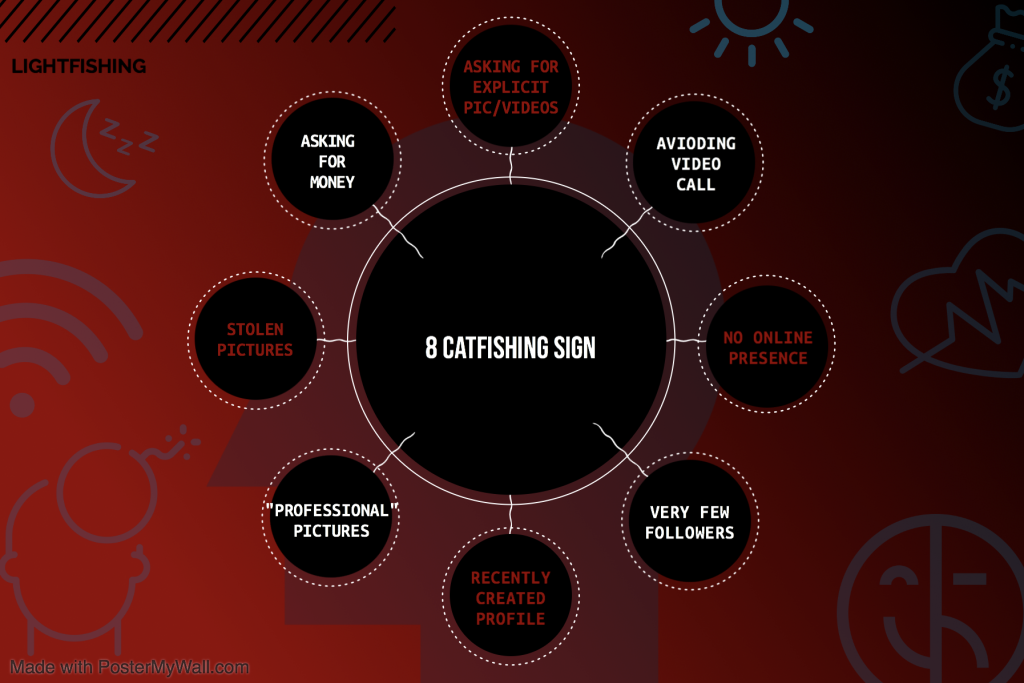This increases the effectiveness of the intervention test, and many people may not have time to go to the exhibition specifically, so people who receive the flyer can directly receive the information content. In order to achieve increased vigilance against catfishing.

*Back of the poster.
Catfishers are generally excellent at tricking their victims. They rely on the emotions of affection and infatuation to cloud their victim’s judgment. Nevertheless, there are usually a few clear warning signs you are being catfished. We will go over these red flags below and elaborate on each of the signs.
1. Avoiding (video) calls
Catfishers want to avoid situations where their true identity is exposed. Therefore, they’ll never agree to a video chat or to meet up in person. Often, they won’t even accept a regular call (without video). After all, even their voice could expose information they don’t want you to know, such as them being a man instead of a woman or vice versa. Therefore, if someone you met online has constant excuses not to meet up or have a (video) call, this should be a definite red flag for catfishing.
2. No online presence (on other platforms)
A large part of our presence is online these days. Therefore, you can expect someone active on one social platform to also be active on others. This is even truer when we focus on a younger demographic, where catfishing is rampant.
Ask yourself: Why does that successful businessman you just met on Facebook not have a LinkedIn page to promote his company, or even to look for new partnerships and recruits? Why does that beautiful fitness model chatting you up on Tinder not have examples of her work on Instagram or her Facebook page?
If the person you just met has a very lacking online presence, ask yourself why. Especially when combined with other signs, this might just be a red flag.
3. Very few friends or followers
When someone approaching you online has very few friends on Facebook or followers on Instagram, this could be a red flag for catfishing. Most people use social media to connect and keep in touch with people online. Supposedly, part of this process is having a decent online circle to communicate or keep in touch with.
Of course, this doesn’t always mean you’re dealing with a catfisher. If a profile doesn’t have this social circle, this could be because they’re new on the platform or simply prefer not to have too many contacts. It could also be a sign that keeping in touch with family, friends, colleagues, and acquaintances is not the primary goal of their social media use. Even so, be very cautious when a profile has very few friends or followers.
4. A very recently created profile
If a social media profile was very recently created, this could be a red flag. This is especially something to look out for if a profile does have a decent number of friends or followers, but something still seems “fishy.”
A recently created profile could just mean someone is genuinely new to a social medium. But it could also mean they frequently create fake profiles to find new victims to catfish. After all, once a profile is flagged or reported on a social medium, it’s often removed. As such, catfish often create many fake profiles, either one after another or simultaneously.
5. “Professional” pictures
Another huge giveaway that something’s off is if your romantic interest only has professional-looking pictures on their profile. Most people on social media — celebrities and influencers excluded — mainly upload pictures taken by family and friends and some selfies.
If you encounter a profile full of professional-looking pictures, this might be either a sign they’re using someone else’s photos (more on this later), or they went through great effort to make themselves look better than they really are. In both instances, it’s wise to ask yourself why.
Even if they are their real photos, it’s probable someone’s trying to lure you in with excessively flattering pictures. Of course, plenty of (aspiring) models promote themselves on social media, but how many of those approach random strangers online out of romantic interest?
6. Stolen pictures
Needless to say, the use of stolen pictures online is an even more serious sign of malicious intent than using stock, professional photos. If someone is using stolen pictures, it’s very likely they are out to scam you. After all, scamming people on social media is one of the most common reasons for creating fake accounts.
Fortunately, it’s often quite easy to find out whether someone is using stolen pictures on social media. You can simply use Google reverse image search to find similar pictures like the one used by your (potential) catfisher and find out where they come from. To do this, simply go to Google Images and click on the little camera icon to upload a picture or paste a picture’s URL and start your search.
7. Asking for money
This is one of the most obvious signs you’re dealing with a catfish. After all, a common reason for catfishing people is to come up with excuses to ask them for money down the line. Ask yourself: How likely is it that you would ask someone you just met online for money, especially if you’re hoping to have a relationship with them?
8. Asking for explicit pictures or videos
Asking for explicit pictures or videos can be a huge red flag. This could mean the asker is trying to combine catfishing with another dangerous form of cybercrime: sextortion. In this scenario, catfishing is actually used to obtain sensitive images of you, which will later be used as leverage to extort you into providing more images or paying the “sextorter.”